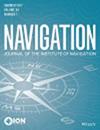Characterization and Performance Assessment of BeiDou-2 and BeiDou-3 Satellite Group Delays
IF 2
3区 地球科学
Q1 ENGINEERING, AEROSPACE
引用次数: 4
Abstract
Based on one year of data, a comprehensive assessment of broadcast group delays and differential code biases (DCBs) from network solutions is presented for all open BeiDou signals. Daily DCB estimates exhibit a precision of 0.1 ns, which also places a limit on long-term variations of the satellite group delays. On the other hand, the estimated DCBs show a notable dependence on the employed receivers, which causes inconsistencies at the few-nanosecond level between BeiDou-2 and BeiDou-3 satellites. Systematic satellite-specific offsets can likewise be identified in broadcast group delay values and clock offsets. These constitute the dominant contribution of the signal-in-space range error (SISRE) budget and are a limiting factor for single point positioning and timing. Use of the modernized B1C/B2a signals is therefore recommended instead of B1I/B3I. This offers a SISRE reduction from about 0.6 m to 0.45 m and also improves the consistency of precise clock and bias products derived from heterogeneous receiver networks.北斗2号和北斗3号卫星群时延特性与性能评估
基于一年的数据,对所有开放的北斗信号的网络解决方案的广播组延迟和差分码偏差(DCBs)进行了全面评估。每日DCB估计的精度为0.1纳秒,这也限制了卫星群延迟的长期变化。另一方面,估计的dcb显示出对所使用的接收机的显著依赖,这导致北斗2号和北斗3号卫星之间在几纳秒级的不一致。系统卫星特定的偏移量同样可以在广播组延迟值和时钟偏移量中确定。这些构成了空间信号距离误差(SISRE)预算的主要贡献,并且是单点定位和授时的限制因素。因此,建议使用现代化的B1C/B2a信号代替B1I/B3I。这可以将SISRE从约0.6 m降低到0.45 m,并且还可以提高来自异构接收器网络的精确时钟和偏置产品的一致性。
本文章由计算机程序翻译,如有差异,请以英文原文为准。
求助全文
约1分钟内获得全文
求助全文
来源期刊

Navigation-Journal of the Institute of Navigation
ENGINEERING, AEROSPACE-REMOTE SENSING
CiteScore
5.60
自引率
13.60%
发文量
31
期刊介绍:
NAVIGATION is a quarterly journal published by The Institute of Navigation. The journal publishes original, peer-reviewed articles on all areas related to the science, engineering and art of Positioning, Navigation and Timing (PNT) covering land (including indoor use), sea, air and space applications. PNT technologies of interest encompass navigation satellite systems (both global and regional), inertial navigation, electro-optical systems including LiDAR and imaging sensors, and radio-frequency ranging and timing systems, including those using signals of opportunity from communication systems and other non-traditional PNT sources. Articles about PNT algorithms and methods, such as for error characterization and mitigation, integrity analysis, PNT signal processing and multi-sensor integration, are welcome. The journal also accepts articles on non-traditional applications of PNT systems, including remote sensing of the Earth’s surface or atmosphere, as well as selected historical and survey articles.
 求助内容:
求助内容: 应助结果提醒方式:
应助结果提醒方式:


